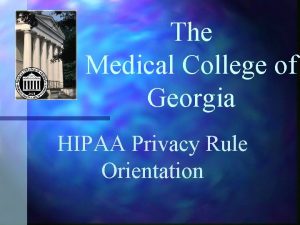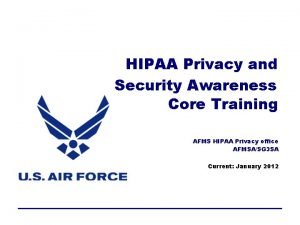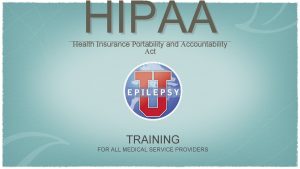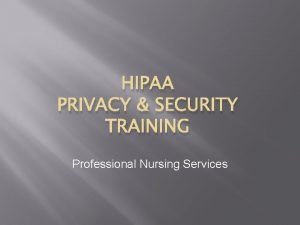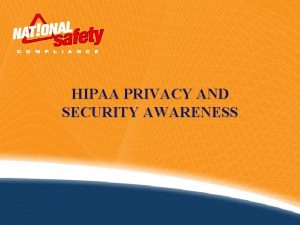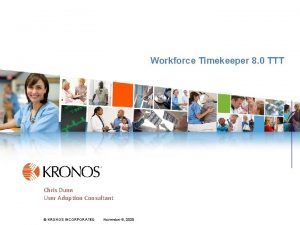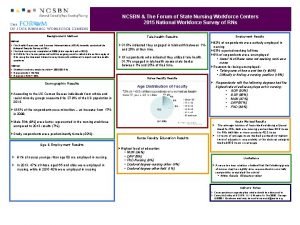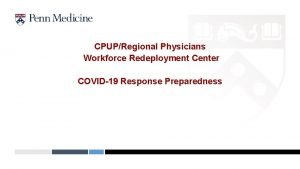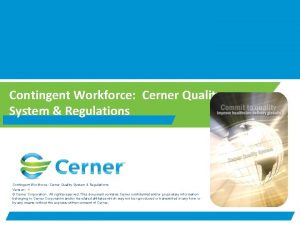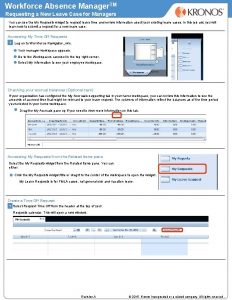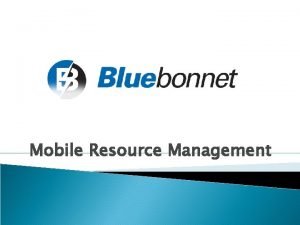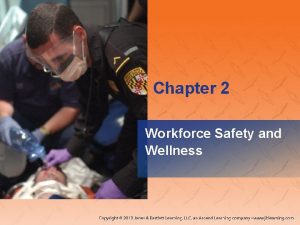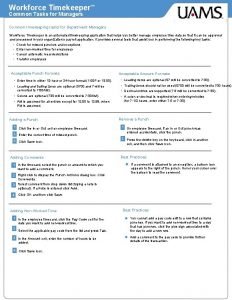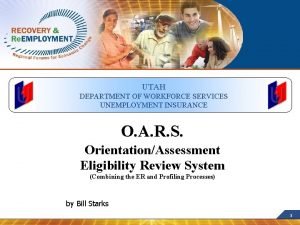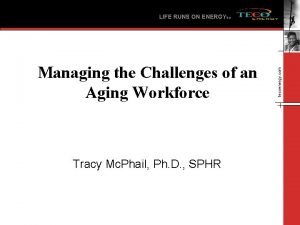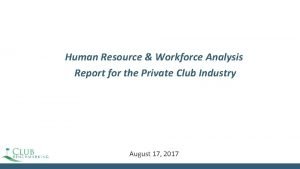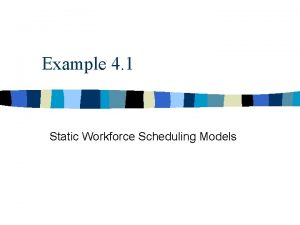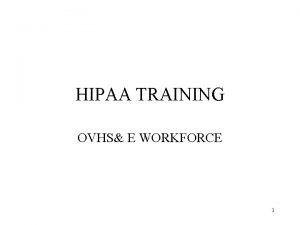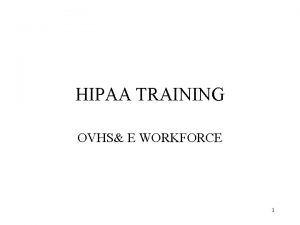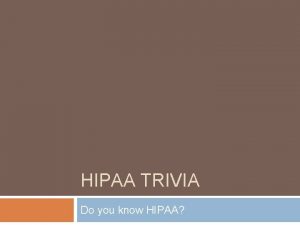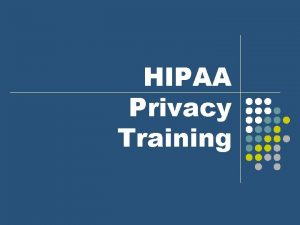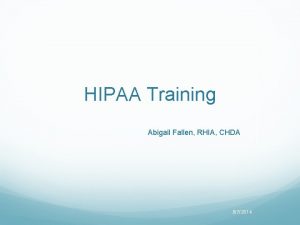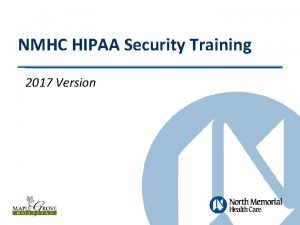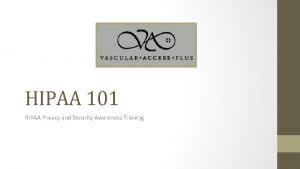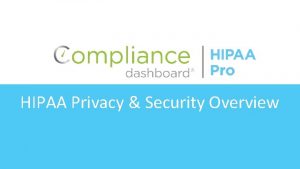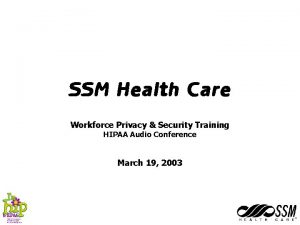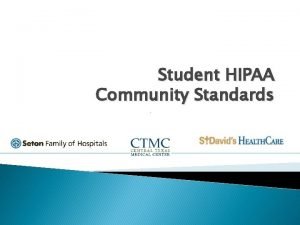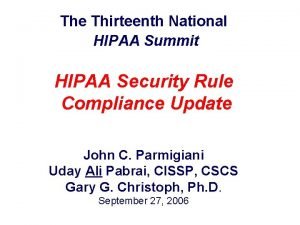HIPAA TRAINING OVHS E WORKFORCE 1 HISTORY HIPAA
































































- Slides: 64

HIPAA TRAINING OVHS& E WORKFORCE 1

HISTORY • HIPAA stands for “Health Insurance Portability and Accountability Act of 1996” • HIPAA was passed in 1996 as part of a broad congressional attempt at healthcare reform • This training will address Title II of the Act. Administrative Simplification 2

PURPOSE • To increase the efficiency and effectiveness of the health care system through standardization • To enhance the security and privacy of Protected Health Information (PHI) • According to the Department of Health and Human Services 1 in 6 patients omit sensitive information when discussing medical history with their physician out of fear of misuse or mishandling. 3

COMPONENTS • PRIVACY STANDARDS – April 14, 2003 • Electronic Transactions Standards – Oct 16, 2003 • Security Standards – April 20, 2005 • Training today will focus on the Privacy Standards 4

HIPAA APPLIES TO COVERED ENTITIES • • Hospitals Physicians Home Health Agencies Pharmacy Dentists Durable Medical Equipment Companies Health Plans 5

PRIVACY STANDARDS KEY FEATURES • • • Minimum Necessary PHI • Patient Rights Uses & Disclosures • Penalties Authorization Notice of Privacy Practices 6

PENALTIES WHY YOU WANT TO LISTEN TO THIS PRESENTATION 7

CIVIL PENALTIES • $100 per violation person up to a maximum of $25, 000 person per year per standard violation • These penalties can be assessed against individual employees 8

CRIMINAL PENALTIES • Up to $50, 000, 1 year in prison, or both, for inappropriate use of PHI • Up to $100, 000, 5 years in prison, or both for using PHI under false pretenses • Up to $250, 000, 10 years in prison or both, for the intent to sell or use PHI for commercial advantage, personal gain, or malicious harm • These penalties can be assessed against individual employees 9

PRIVACY RULE • Regulates the internal use and external disclosure of protected health information (PHI) by organizations and their employees • For example, PHI cannot be discussed in places like elevators, hallways, the cafeteria, or the butt hut 10

EXAMPLE VIOLATION A nurse sees an acquaintance has checked into the hospital and discovers he is scheduled for surgery. She calls a few of his friends to make sure they are aware of this, thinking they can wish him well or be of some assistance to his family. 11

WHAT IS PHI? • Oral, written, and electronic communication • Health and demographic information about an individual that is transmitted or maintained in any form where the information is created or received by a health care provider, health plan, employer or health care clearinghouse • Includes past, present, and future health information 12

EXAMPLES OF PHI • • Name Address Birthdate Admission date Discharge date Date of death Telephone numbers Fax number • • E-mail address Social Security # Medical record # Account # Certificate/license # Photographs All clinical data 13

PERMITTED USES & DISCLOSURES • • Treatment Payment Health Care Operations Referred to as “TPO” 14

OTHER USES & DISCLOSURES • Some disclosures are mandated by law such as health oversight activities, public health concerns, FDA etc • ALL OTHER USES OR DISCLOSURES OUTSIDE OF TPO REQUIRE AN AUTHORIZATION 15

TREATMENT • To a consulting physician • To a post discharge provider such as, a rehab unit, skilled unit, or home health agency • To another department within the hospital 16

PAYMENT • • • Medicare/Medicaid Insurance Companies Workers’ Compensation Liability Carrier Provision of billing information to a physician who treated the patient at the hospital • To the billing companies for the emergency room physicians or radiologists 17

HEALTHCARE OPERATIONS • • • Quality assessment and improvement Peer review and credentialing activities Legal services Auditing services Business planning and development 18

AUTHORIZATION • Authorization must be obtained for ALL uses and disclosures other than TPO or those mandated under law. • Authorizations must include: Description of the information Name of person/entity to release to Expiration date Information regarding right to revoke Date and signature 19

PRIVACY NOTICE • Every patient must receive a copy of the OVHS&E privacy notice the first time they receive services after April 14, 2003 • The notice must be posted in areas easily seen by patients • The notice must be posted on the official website 20

PRIVACY NOTICE REQUIREMENTS • Be in plain language • Contain a description and example of TPO • Contain a description and example of other uses and disclosures not requiring Authorization • Include statements about an individual’s rights • Include statements about the duties of the provider • Describe the complaint process 21

MINIMUM NECESSARY The privacy rule requires covered entities to use or disclose only the “minimum necessary” PHI to accomplish the intended purpose of the use, disclosure, or request 22

INTERNAL REQUIREMENTS • Identify workforce who need access to PHI • For each job code, limit access based on a need-to-know basis • OVHS&E has established standard menus for each separate job code. Variance from the standard must have approval. • Employees are obligated to only use the access they have to perform their job duties. 23

EXTERNAL REQUIREMENTS • Limit access to what is needed to accomplish the purpose for which the request was made • Do not send a requestor an entire medical record if they ask for insurance information or a particular lab result 24

EXAMPLE VIOLATION • You go to lunch with your friend from another department. At lunch your friend says, “ We have really been busy this morning. Dr. Welby saw 20 patients this morning”. You ask if Theodore Cleaver is Dr Welby’s patient and your friend replies, “yes, didn’t you know he had open heart surgery? ” 25

PATIENT RIGHTS • • Receive written notice of privacy practices Request restrictions on uses & disclosures Access, inspect & copy their PHI Request amendment or correction of their PHI • Receive an accounting of disclosures of their PHI • Request confidential communications 26

CONFIDENTIAL COMMUNCIATIONS • A patient has a right under HIPAA to request alternate methods of communication • The hospital must honor those requests if they are reasonable 27

RIGHT TO INSPECT AND COPY • Patients have the right to inspect and copy their medical information • This includes medical and billing records, but excludes psychotherapy notes 28

RIGHT TO AMEND • Patients have a right to request an amendment to their record as long as the information is kept by the hospital • Any requests for amendments must be in writing and submitted to Medical Records • Hospital may deny the request to amend the information 29

DENY REQUEST TO AMEND • If the request is not in writing • If the portion of the record was not created by us originally • If the original record is accurate and complete 30

RIGHT TO REQUEST RESTRICTIONS • Patients have a right to request a restriction or limitation on the medical information the hospital uses or discloses about them for TPO • Hospital is not required to agree to the restriction • If we do agree to the restriction, we must comply with the restriction unless the information is needed to provide the patient with emergency treatment 31

ACCOUNTING FOR DISCLOSURES • Under HIPAA, patients have a right to request an accounting of all disclosures we have made of their PHI • We do not have to list those for TPO • We must track all others disclosures • We do have to disclose any inappropriate disclosures 32

INAPPROPRIATE DISCLOSURES • If results are reported to a physician who is not that patient’s physician • If we fax information to the wrong fax number • If we discover through an audit that inappropriate access has occurred • If information is left unattended and unauthorized personnel review it 33

EXAMPLE VIOLATION • There are 2 doctors with the same name – Dr. Marcus H. Welby and Dr. Marcus W. Welby. Patient of Dr. Marcus H. Welby presents for lab testing and he is incorrectly registered to Dr. Marcus W. Welby. Lab reports results to Dr. Marcus W. Welby instead of Dr. Marcus H. Welby 34

REPORTING INAPPROPRIATE DISCLOSURES • All inappropriate disclosures must be reported to the Privacy Officer • It will be the responsibility of the Privacy Officer to log all inappropriate disclosures • Inappropriate disclosures will be tracked by employee and appropriate disciplinary action will be taken 35

HOSPITAL REQUIREMENTS • Designate a privacy officer with primary responsibility for ensuring compliance with the regulations • Establish training programs for all members of the workforce • Implement appropriate policies & procedures to prevent intentional and accidental disclosures of PHI 36

HOSPITAL REQUIREMENTS • Establish a system for receiving and responding to complaints regarding privacy practices • Implement appropriate discipline for violations of the privacy guidelines • Make reasonable efforts to limit information to the minimum necessary to accomplish a person’s job 37

EMPLOYEE OBLIGATIONS • Report any inappropriate disclosures or breaches of patient confidentiality to the Privacy Officer • Sign a confidentiality statement annually • Keep patient PHI confidential at all times • Access information on a “need to know” basis 38

ENFORCEMENT • THE PUBLIC – The public will be educated about their privacy rights and will not tolerate violations to their privacy. • OFFICE OF CIVIL RIGHTS – They will provide guidance and monitor compliance. • DEPARTMENT OF JUSTICE – They will be involved in criminal and privacy violations. 39

OVHS&E PLAN 40

PRIVACY NOTICE • OVHS&E has developed a privacy notice to be used at all facilites and all physician offices • Privacy notice will be given to patients on their first encounter here beginning April 14, 2003 • Privacy notice will be posted at all registration sites and other patient areas • Privacy notice will be posted on the hospital website 41

RELEASING PATIENT INFORMATION If someone calls and asks for a person by name (first and last name) they will be told that the patient is here, where they are and their “one word” condition except in those situations where we make the patient confidential 42

CONFIDENTIAL PATIENTS • The Admitting department has the capability to make any patient confidential • When you access that patient in various modules it will be noted that they are confidential • Patients are denoted as confidential in various ways in Meditech. Some modules display a lower case c in front of the name and some post a notice that the patient is confidential • If a patient tells you they want to be confidential, notify the Admitting Office 43

CONFIDENTIAL PATIENTS • Some patients are automatically made confidential patients: Psych patients Inmates Patients who request confidential status 44

OPTING OUT OF DIRECTORY • If patients chose to opt out of the directory, they must do so in writing • If patients request to opt out of the directory, they should be referred to Admitting • Patients should be notified that callers/visitors will be told that we have no information on this patient • Deliveries of cards and flowers will be delayed 45

INMATES • Correctional institutions request additional protection on disclosures regarding inmates to insure the safety of the inmate and hospital staff and visitors • No information should be given on inmates unless approved by officials from the correctional institution and hospital management 46

MEDIA • If the media calls about a patient they are to be referred to the appropriate public relations personnel or the house supervisor on off hours • Media is only given information that the patient is here and their “one word” condition and only if the media knows the patient name (first and last) • Some members of media will be aggressive to obtain information, but there are no circumstances where they will be given more information unless the patient requests and authorizes it. 47

MEDICAL INFORMATION PASSWORD • In order to provide the patients with a mechanism to allow their family/friends to obtain more information than just their “one word” condition we have established a medical information password • Will be given to all inpatient and observation patients • Will be assigned by Admitting and given to the patient at the time of registration 48

MEDICAL INFORMATION PASSWORD • Patient will be instructed to give this 4 digit code to individuals allowed to obtain information • If someone calls an area and asks for information about a patient, they will only be given the “one word” condition unless they know the valid code. • Patients can have their code changed if necessary by contacting the Admitting Office. 49

ACCESSING RECORDS • Records of patients should only be accessed if you have a reason to do so to perform your job duties • You do not have the authority to access any other record just because you have the computer access. In other words, if you have access to PCI, you cannot look up your father-in-law’s records unless you need to do so to perform your job duties • All access is monitored and audit trails do exist • Employees have been terminated based on those audit trails 50

ACCESSING RECORDS • Very important to sign off the computer when you walk away from it so others can’t use your password for inappropriate access • Any access under your password is considered yours • If you feel someone else has your password, contact Information Systems to have it changed • Do not share your password with anyone 51

ACCESSING RECORDS • We are no longer allowing employees access to their own record or the records of their children • Must now go through the same process as any other patient • Will be required to go to Medical Records to obtain records • Some records of your child are now protected under the law and even a parent does not have access. Examples include, certain psych records and HIV testing 52

FAXING PHI • Whenever you are faxing PHI outside of the facility, a cover sheet must be used • Use a cover sheet when faxing within the facility when the fax is directed towards a specific employee • The cover sheet must be the OVHS&E cover sheet which includes appropriate HIPAA language • Do not use any unauthorized cover sheets 53

FAXING PHI • When faxing, double check the number entered prior to sending the fax • If you realize you have faxed to the wrong number contact them immediately and retrieve the information sent • We had a situation where a psych record was faxed to a wrong person. Under HIPAA this could have resulted in a substantial fine to the individual who faxed it and to the hospital 54

FAXING • Fax records only when it is absolutely necessary for the further treatment of the patient • Fax only those records that must get there immediately 55

OTHER STEPS TO PROTECT THE PRIVACY OF OUR PATIENTS • Do not leave the records of patients laying around in unsupervised areas • If you print PHI out destroy it immediately after you are done with it • If you take copies of PHI to a meeting and pass them out make sure you collect all copies at the end of the meeting and discard them appropriately • Any copies of PHI should be shredded 56

PRACTICAL STEPS • Dictation and phone calls should occur in private areas • Cell phones should only be used in emergency situations and must be used in private areas • Conversations among employees regarding patients must occur in private areas 57

PRACTICAL STEPS • Close exam room doors whenever you are reviewing information with the patient or when you are performing a test or procedure • Use common sense – if the roles were reversed would you feel that your privacy was being adequately protected 58

MESSAGES • If you call a patient and must leave a message, leave the minimum amount of information possible • For example, “This call is for Lee Smith, please call the Admitting Office at “ • If you call someone and receive another member of the household do not answer any questions such as, what test are they having done or what is wrong with them etc. 59

NEED TO KNOW • Information regarding a patient should only be given to employees who have a need to know • OR Schedules, Admission lists etc are only intended for those who need that information to perform their job duties • As employees we are not automatically entitled to information 60

HOW TO REPORT • Inappropriate disclosures or breaches of patient confidentiality should be reported to one of the following: Privacy Officer Department Manager Compliance Hotline (8181) 61

SUMMARY • HIPAA policies are located in the MOX Library under compliance policies • Revised forms are also available in the library • Destroy all forms such as authorizations and fax cover sheets which have been revised • Questions should be referred to the Privacy Officer or any member of the HIPAA Committee 62

HIPAA GOLDEN RULE MAINTAIN PATIENT INFORMATION IN THE SAME MANNER YOU WOULD WANT SOMEONE TO MAINTAIN YOUR PATIENT INFORMATION 63

FINAL THOUGHTS • REMEMBER – A Breach of confidentiality can be costly to the organization and to you personally • WILL RESULT IN DISCIPLINARY ACTION – MOST LIKELY TERMINATION OF EMPLOYMENT 64
 Project implementation plan template
Project implementation plan template Hipaa training georgia
Hipaa training georgia Cvs privacy awareness and hipaa privacy training
Cvs privacy awareness and hipaa privacy training Air force hipaa training
Air force hipaa training Accountable hipaa training
Accountable hipaa training Hipaa training strategies
Hipaa training strategies Hipaa training for nurses
Hipaa training for nurses Hipaa privacy and security awareness training
Hipaa privacy and security awareness training Timekeeper
Timekeeper Workforce analysis
Workforce analysis Education workforce council
Education workforce council Zero based forecasting
Zero based forecasting California workforce registry
California workforce registry Workforce planning nedbank
Workforce planning nedbank Quintiq rostering
Quintiq rostering Regional centers for workforce transformation
Regional centers for workforce transformation Call center school workforce management
Call center school workforce management National forum of state nursing workforce centers
National forum of state nursing workforce centers Compensating the flexible workforce
Compensating the flexible workforce P20 workforce
P20 workforce Impact 360 workforce management
Impact 360 workforce management Hr metrics and workforce analytics
Hr metrics and workforce analytics Transforming the workforce
Transforming the workforce Workforce redeployment
Workforce redeployment Workforce.cerner.com
Workforce.cerner.com Offender workforce development specialist
Offender workforce development specialist Digital ready workforce
Digital ready workforce Avaya workforce management
Avaya workforce management Role segmentation workforce planning
Role segmentation workforce planning Bmc kronos
Bmc kronos Workforce analysis
Workforce analysis Workforce intelligence network
Workforce intelligence network Kronos historical edit
Kronos historical edit Workforce absence manager
Workforce absence manager Workforce flow
Workforce flow School workforce census 2017
School workforce census 2017 Lousiana workforce commission
Lousiana workforce commission Virginia workforce connection
Virginia workforce connection Mobile workforce intelligence
Mobile workforce intelligence Golden sierra workforce development board
Golden sierra workforce development board Centralina workforce development board
Centralina workforce development board Ewc hearing outcomes
Ewc hearing outcomes People who work with computers while doing business
People who work with computers while doing business Chapter 2 workforce safety and wellness
Chapter 2 workforce safety and wellness Kronos workforce autotime
Kronos workforce autotime Workforce timekeeper
Workforce timekeeper Strategic workforce planning toolkit
Strategic workforce planning toolkit Utah department of insurance
Utah department of insurance Evolution of workforce management
Evolution of workforce management California workforce registry
California workforce registry Strategic workforce
Strategic workforce Contingent workforce compliance
Contingent workforce compliance Indebtedness and deregulation in hrm
Indebtedness and deregulation in hrm Talent analyst emsi
Talent analyst emsi Cayenta
Cayenta Workforce optimization strategies
Workforce optimization strategies Role segmentation workforce planning
Role segmentation workforce planning Pcmm
Pcmm Oracle workforce scheduling
Oracle workforce scheduling Managing the aging workforce challenges and solutions
Managing the aging workforce challenges and solutions Workforce analysis report
Workforce analysis report What evidence is there of aldi motivating its workforce
What evidence is there of aldi motivating its workforce Firstline workforce
Firstline workforce Strategic workforce planning swp
Strategic workforce planning swp Workforce scheduling model
Workforce scheduling model

